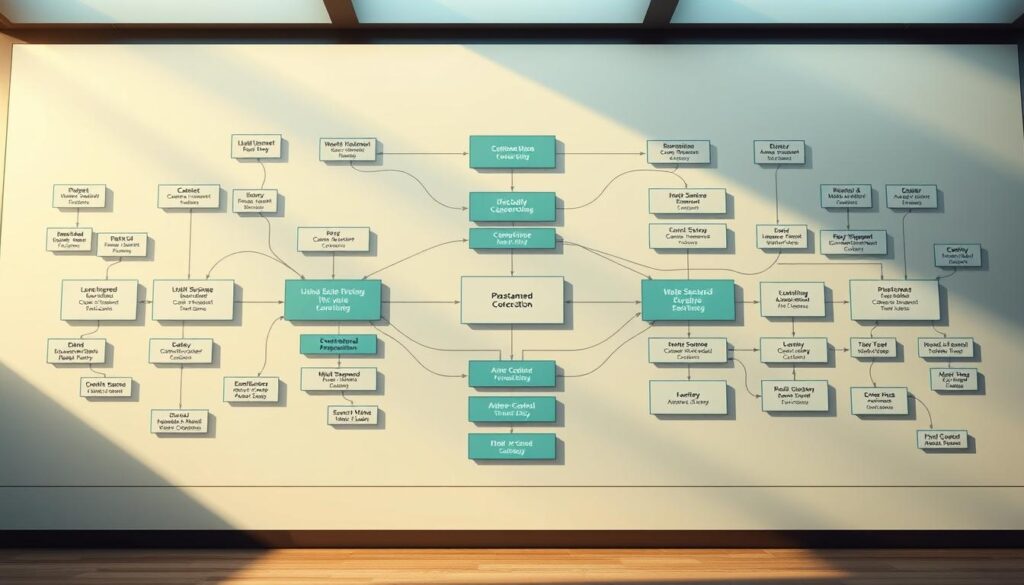The digital landscape has transformed as search engines evolve beyond keyword matching. With Google’s Search Generative Experience (SGE) integrating large language models (LLMs), websites now compete in generative engines and traditional search results. This shift demands a dual approach: optimizing for both human users and AI systems that analyze context, intent, and semantic relationships.
Modern algorithms prioritize content quality over keyword density. They assess how well information addresses user needs, evaluates source credibility, and connects related concepts. For instance, AI agents now parse content structures, multimedia relevance, and even subtle thematic patterns to determine rankings.
Generative search experiences create synthesized answers by cross-referencing multiple sources. This means websites must establish topical authority through comprehensive coverage rather than isolated keyword targets. Organizations blending traditional SEO practices with machine learning adaptation strategies see better visibility across all search formats.
Key Takeaways
- Search algorithms now prioritize contextual understanding over exact keyword matches
- Large language models analyze content depth and source reliability for ranking decisions
- Generative search results combine information from multiple high-authority websites
- Optimization requires balancing technical SEO with semantic content structuring
- Successful strategies address both traditional search and AI-generated answer interfaces
Introduction to the New Era of SEO

The rules of digital discovery are being rewritten as generative systems reshape how information reaches users. Traditional search engines now share space with AI-powered platforms that synthesize answers rather than merely list links. This evolution demands a fresh approach to optimization—one that prioritizes contextual intelligence over mechanical keyword alignment.
Defining AI-Driven Search and GEO
Generative Engine Optimization (GEO) represents the next frontier in digital visibility. Unlike conventional SEO tactics focused on backlinks and exact-match phrases, GEO targets language model comprehension. Systems like Google’s SGE analyze content through neural networks that map semantic relationships, evaluating how well material answers implied questions.
Understanding the Shift from Traditional Search Engines
Three critical changes define modern search ecosystems:
- Natural language processing replaces keyword counting
- Cross-source synthesis overtakes single-page rankings
- User intent analysis dominates over query matching
This transition requires creators to develop AI-powered tools that craft content addressing layered contexts. For example, a travel guide optimized for generative engines might explain “family-friendly Rome attractions” through safety considerations, accessibility features, and age-appropriate activities—elements traditional SEO might overlook.
“The future belongs to content that teaches machines before it informs humans.”
As language models become primary information curators, success hinges on structuring material for algorithmic comprehension first. This doesn’t negate traditional SEO principles but layers machine-readable signals atop human-centric writing.
The Evolution of SEO in the Age of AI

Search optimization strategies have undergone radical transformations since the first meta tags dominated digital marketing. A Surfer SEO analysis of 405,576 AI Overviews reveals exact keywords appear just 5.4% of the time—proof that context now drives visibility more than mechanical repetition.
Historical Trends and Current Developments
Early SEO focused on keyword density and backlink quantity. Modern algorithms prioritize three elements:
- Content depth addressing user questions
- Semantic connections between concepts
- Technical foundations like mobile responsiveness
Traditional SEO tactics still matter, but they now serve as entry points rather than end goals. Websites ranking highest combine classic techniques with machine-readable signals that demonstrate topical expertise.
Impact of Large Language Models on Content Visibility
Large language models analyze material through contextual lenses rather than phrase matching. This shift means quality content must:
- Answer implied questions beyond stated keywords
- Connect ideas through natural language patterns
- Reference authoritative sources within the text
While AI-generated answers reduce some clicks, 83% of users still click standard search results according to SimilarWeb data. Successful strategies optimize for both formats—securing featured snippets while maintaining traditional rankings.
How to Leverage AI-driven page ranking for Better Results

Modern search behavior increasingly mirrors natural conversation, requiring creators to optimize for dialogue-style queries. Professionals must prioritize long-tail phrases like “best budget hiking boots for beginners” over generic terms. These multi-word searches account for 72% of AI-generated summaries in tools like Google’s SGE.
Effective strategies blend classic SEO with machine-readable formatting. Content should answer questions directly using headers like “How does…” or “Why is…” to align with how language models parse information. For example, strategies for making money with AI-powered succeed when structured as step-by-step solutions rather than broad overviews.
Data shows AI overviews appear for 89% of informational searches. Create material that:
- Explains processes with numbered lists
- Compares options using tables
- Defines technical terms in context
Tools like AnswerThePublic reveal rising question-based queries. Focus on phrases with 3-4 words that reflect real user needs, such as “optimize images for SEO” rather than “image SEO.” This approach helps content surface in both traditional results and AI-generated answers.
Success requires balancing depth with clarity. Break complex topics into digestible sections using bullet points and visual aids. Search systems reward content that serves dual purposes – educating users while providing structured data for algorithmic analysis.
Essential Components of a Successful AI-Enhanced Strategy

Modern search ecosystems demand content that communicates effectively with both users and algorithms. Two pillars form the foundation of AI-ready material: machine-readable organization and contextual clarity. These elements enable search systems to parse information while maintaining human engagement.
Integrating Structured Data and Schema Markup
Structured data acts as a universal translator for AI systems. By tagging content with schema markup, websites provide explicit clues about product details, event dates, or article authors. This standardization helps language models:
- Identify key information without ambiguity
- Connect related concepts across pages
- Assess content relevance to specific queries
For example, recipe sites using schema markup see 35% better visibility in AI-generated cooking tips. The systematic implementation of these tags turns raw data into actionable insights for search algorithms.
Optimizing for Semantic Search and Entity Signals
Semantic search prioritizes meaning over matching words. Content must establish clear relationships between entities—people, places, or concepts. A travel guide discussing “Paris” should contextually link to “Eiffel Tower” and “Louvre,” not just repeat the city’s name.
Effective strategies use creative prompts for structured data implementation to reinforce these connections. This approach helps AI systems map content to user intent, increasing relevance for complex queries like “best weekend cultural itineraries.”
“Structured data is the Rosetta Stone for algorithmic content comprehension.”
By combining technical markup with semantic richness, creators build content that performs across all search formats. This dual optimization ensures visibility in traditional results and AI-generated answers alike.
Optimizing Content for Both Traditional and AI-Driven Search

Content creation now demands a dual focus: satisfying algorithmic requirements while mirroring human conversation. This balance ensures visibility across traditional search results and AI-generated answers. The key lies in crafting material that technical systems parse effectively and users find genuinely helpful.
Balancing Keyword Research with Natural Language
Modern language models analyze entire paragraphs rather than isolated phrases. They prioritize comprehensive explanations over fragmented keyword clusters. For example, an article about hiking trails performs better when discussing “terrain difficulty” and “safety precautions” naturally than repeating “best hiking spots” mechanically.
Effective strategies blend semantic depth with technical precision. Tools like AI-powered writing assistants help creators identify conversational phrases that align with search intent. These solutions analyze user questions to suggest context-rich terminology that satisfies both algorithms and readers.
Three principles guide this hybrid approach:
- Structure answers around implied questions (“How does…”, “Why is…”)
- Use synonyms and related terms organically within explanations
- Maintain keyword relevance without sacrificing readability
“Optimization now means teaching machines through human-centered storytelling.”
This methodology proves particularly effective for traditional search updates and AI systems alike. Content ranking well in both environments typically demonstrates:
- Clear section headers mapping to user intent
- Conversational explanations of complex topics
- Strategic placement of core terms within natural phrasing
The evolution demands creators think like educators—explaining concepts thoroughly while signaling relevance to search algorithms through semantic structure. This dual optimization ensures visibility across all discovery channels.
Implementing Technical SEO for Improved AI Comprehension

Technical foundations now dictate visibility in AI-enhanced search ecosystems. Websites must align their architecture with machine-readable standards while maintaining human-centric usability. This dual optimization ensures content remains accessible to evolving algorithms and real users alike.
Best Practices for Site Structure and Mobile Responsiveness
Google’s 2.5-second load time benchmark highlights the critical role of speed in modern search. Slow websites lose visibility as 81% of AI-generated answers prioritize mobile-friendly sources. Use tools like Google PageSpeed Insights to identify performance gaps and SE Ranking’s Mobile Friendly Test to verify cross-device compatibility.
Logical site structure helps AI systems map content relationships. Create clear navigation paths through:
- Hierarchical URL organization
- Contextual internal linking
- Consistent header tags (H1-H6)
Mobile optimization extends beyond responsive design. Ensure touch-friendly interfaces and compressed media files. As AI search strategies evolve, technical implementation separates competitive content from obsolete material.
“Technical SEO forms the backbone of algorithmic trust—build it strong, and visibility follows.”
Regular audits using structured data validators and crawl simulators maintain technical health. These practices make sure websites meet both current standards and future AI developments.
Enhancing Engagement through Multimedia and Interactive Content
Visual storytelling now powers modern search experiences. Multimodal large language models like GPT-4o and Gemini analyze images, videos, and charts alongside text. This integration allows search systems to prioritize pages offering varied, accessible information.
Using Images, Videos, and Infographics Effectively
Visual Question Answering (VQA) enables AI to interpret media files when responding to queries. A tutorial video with captions, for example, helps algorithms understand its relevance to “how-to” searches. Optimized multimedia increases visibility in synthesized answers by 47% compared to text-only pages.
Three strategies maximize impact:
- Use descriptive filenames like “climate-change-infographic-2024.jpg”
- Embed charts with alt text explaining key data points
- Structure videos with timestamps for topic segmentation
“Multimedia bridges user curiosity with algorithmic comprehension—each image becomes a data point for AI analysis.”
| Media Type | Optimization Strategy | Engagement Boost |
|---|---|---|
| Infographics | Alt text with trend explanations | 33% longer session duration |
| Tutorial Videos | Chapter markers & transcripts | 2.1x more shares |
| Interactive Charts | Embedded data tables | 41% higher return visits |
Tools like Google’s Vision AI now assess visual relevance to search intent. Pairing infographics with concise summaries creates content that satisfies both users and algorithms. This dual approach improves website authority while delivering answers suited for AI-generated responses.
Improving User Experience and Website Performance
Modern search systems now evaluate websites through human interaction patterns. When visitors struggle to navigate or leave quickly, algorithms interpret this as poor quality. A 300,000+ keyword Ahrefs study confirms: well-structured pages dominate AI-generated summaries due to their ability to hold attention.
Strategies for Faster Load Times and Intuitive Navigation
Speed impacts visibility across all platforms. Google’s Core Web Vitals set clear benchmarks:
- Largest Contentful Paint under 2.5 seconds
- Cumulative Layout Shift score below 0.1
- Interaction readiness within 100 milliseconds
Tools like Lighthouse identify performance gaps. Combine technical fixes with logical menu structures—users should find key content within three clicks. This reduces bounce rates while signaling value to AI evaluators.
Optimizing for Mobile and Cross-Platform Compatibility
Mobile-first indexing makes responsive design non-negotiable. Test layouts across devices using Chrome DevTools. Ensure:
- Text remains readable without zooming
- Buttons spaced for thumb navigation
- Media files adapt to screen sizes
Interactive elements like AI-powered chatbots boost engagement. Pair these with bullet-point summaries to help both users and algorithms grasp key points quickly.
“A slow website teaches algorithms to distrust your content—speed becomes the first credibility checkpoint.”
Prioritize content hierarchy using clear headers and visual breaks. This structure improves comprehension for visitors while providing machine-readable signals about information importance.
Monitoring and Analyzing SEO & GEO Impact
Measuring success in modern search requires tracking both algorithmic signals and user engagement metrics. Platforms like Google Analytics 4 (GA4) and Search Console provide critical insights into how content performs across traditional and generative search environments. These tools reveal patterns in organic traffic, query relevance, and user interaction depth.
Leveraging Analytics Tools Like GA4
Advanced analytics platforms now track metrics essential for dual optimization strategies. GA4’s machine learning capabilities identify which content pieces drive conversions in AI-generated results. Three critical metrics emerge:
1. Query refinement rates show how well material answers follow-up questions
2. Dwell time indicates content depth and relevance
3. Cross-platform engagement highlights multi-format effectiveness
Integrating AI-powered marketing tools with analytics suites creates actionable data streams. For instance, heatmaps might reveal how users interact with AI-synthesized answer boxes. Regular audits using these tools help refine strategies for both human audiences and language models.
Successful teams prioritize data-driven decisions. They compare performance across search formats, adjusting technical and creative approaches based on measurable outcomes. This continuous improvement cycle ensures visibility in evolving digital landscapes.







